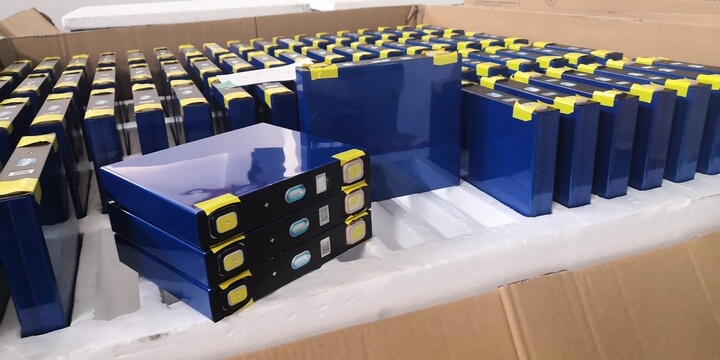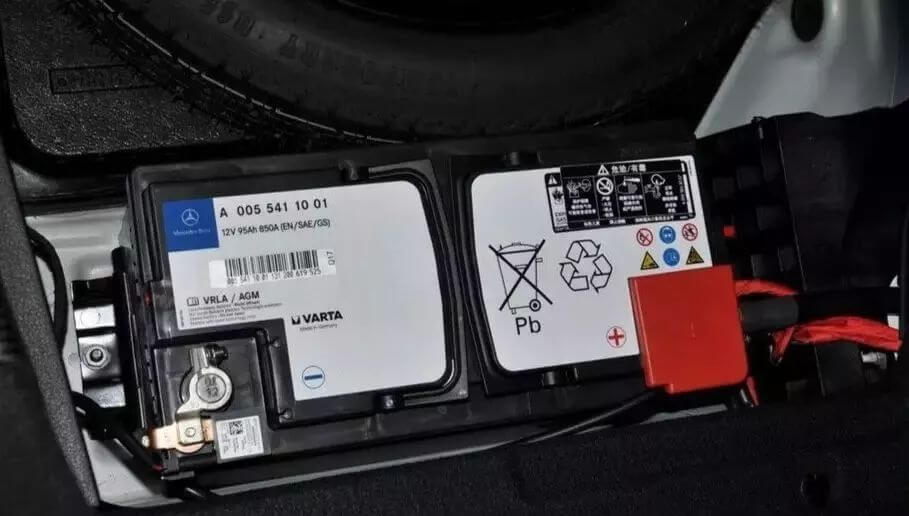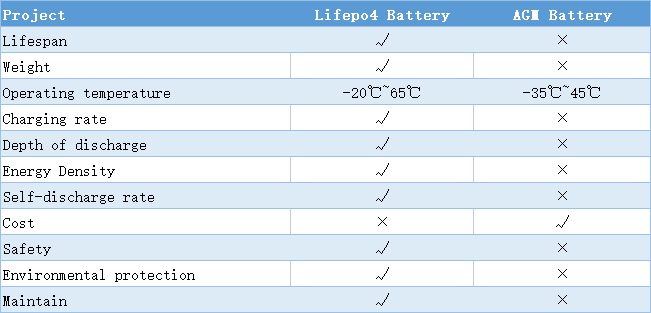Lifepo4 Battery VS AGM Battery - 11 Comprehensive Comparison
Purchasing the correct type of battery is an important decision as it will directly affect the performance of your device. For many devices and applications, lifepo4 and AGM batteries are popular choice types. But what exactly makes them so appealing? What factors should we consider when deciding which type to buy?
In this blog post, we'll explore the pros and cons of lifepo4 and AGM batteries, identifying the key criteria you should keep in mind when choosing either one for your needs.
Read on to learn more about the ideal battery for your project or gadget!

What is the Lifepo4 Battery?
The lifepo4 battery is a lithium-ion technology-based battery. It can be used for a variety of applications, such as in electric vehicles, energy storage systems, and consumer electronics.
This type of battery has many advantages when compared to other lithium-ion chemistries, including low weight, high energy density, and long lifespans.
The lifepo4 battery works by passing an electric current through two electrodes located within its cell: a positive (+) cathode and a negative (-) anode. Through the process of charging, positively charged lithium-ions move from negative electrode to the positive electrode while depleting the electrolyte; while discharging the process is reversed producing energy.

What is the AGM Battery?
An AGM battery, also known as an Absorbent Glass Mat Battery, is an extremely efficient type of lifepo4 (lithium iron phosphate) battery.
It works by using a fiberglass mat between the plates that acts as a sponge for the electrolyte and increases the storage capacity. The electrochemical reaction creates an electric current which is then used to power various electrical components.
AGM batteries are widely used in base stations.
11 Items Comparison of Lifepo4 Battery VS AGM Battery
1. Lifespan
The service life of the battery is mainly determined by the number of cycles. Usually, the cycle number of the Lifepo4 battery is 2000-10000, and the cycle number of the AGM battery is 300-800. According to the average daily charge and discharge cycle, the lifepo4 battery life is almost 6-10 times that of the AGM battery.
In addition, due to the inherent internal resistance of lifepo4 batteries is lower than that of AGM, the battery degradation is less than 1% per year, which also makes lifepo4 batteries much more durable than AGM batteries.

2. Weight
The most notable thing about lifepo4 batteries compared to AGM batteries is their lightweight design. lifepo4 batteries are much lighter than AGM batteries, almost 1/4 times that of AGM, an attractive quality for applications requiring portable power.
At the same time, this also means that the transportation of lifepo4 batteries is more economical, and it is easier to install and can be applied to more fields.
3. Operating temperature
The suitable working temperature range of an AGM battery is -35℃~45℃, and the suitable working temperature range of an LFP battery is -20℃~65℃. In general, AGM is more suitable for the low-temperature environment, while Lifepo4 battery needs Only by gradually adjusting the internal temperature can the battery performance (self-heating function) be better activated
But lifepo4 is more stable than AGM batteries in high-temperature environments, and the battery is applicable to a wider temperature range.
4. Charging rate
On average, lifepo4 batteries charge about four times faster than AGM batteries because they can handle the higher amperage from the charger.
It's worth mentioning that you have more flexibility when it comes to charging the lifepo4 battery. Because of the memoryless nature of the lifepo4 battery, you can start and stop charging as needed without compromising battery performance or lifespan. This means you don't have to worry about being able to complete long charge cycles. However, when you partially charge AGM batteries, they lose their ability to be fully charged over time.
Of course, if fast charging speeds aren't a must for your needs, AGM can still do the trick.
5. Depth of discharge
Depth of discharge (DoD) is the depth to which a battery can be discharged, measured as the energy drawn from the total capacity. An AGM battery typically has a DoD of 50-80%, meaning it can still contain up to 20% of its energy when fully discharged.
Lifepo4 batteries have a higher DoD of up to 95%, which means they can reach their capacity deeper and provide more power while still maintaining a good lifespan, so AGM batteries may need to be replaced more often than lifepo4 batteries replace.
6. Energy Density
Battery energy density is a measure of the energy that can be stored in a particular battery, and it lets us know how much power each battery can hold. The lifepo4 battery has an energy density of up to 180 Wh/kg, while the AGM battery has an energy density of up to 45 Wh/Kg. Only 1/4 of the Lifepo4 battery.
This means that the same power needs to be matched with more AGM batteries and takes up more space.
7. Self-discharge rate
The self-discharge rate of Lifepo4 battery is about 1%-2% per month. The self-discharge rate of AGM batteries is about 2%-3%. Therefore, the Lifepo4 battery can be stored for a longer time even if it is not in use.
In addition, the lifepo4 battery has no memory effect, and the maximum capacity of the battery will not be lost during long-term storage, while AGM batteries will irreversibly damage the maximum capacity of the battery due to long-term inapplicability.
8. Cost
Lifepo4 batteries typically have a more expensive upfront investment, but Lifepo4 batteries are more efficient and last longer, while AGM batteries tend to be cheaper but don't necessarily offer the same level of quality. If you have a long-term and stable power demand, then Lifepo4 battery will definitely bring the highest cost performance. If you only need occasional power, you can choose a cheaper AGM battery to solve the problem.
9. Safety
Lifepo4 battery is the safest lithium battery at present, due to its stable chemical structure, it is not easy to spontaneously ignite, and almost never explodes. Although the AGM battery has 150 years of technical support, it still produces a lot of hydrogen, and it is very easy to cause an explosion if the ventilation is not in place or in a high-temperature environment.
10. Environmental protection
From the perspective of manufacturing materials, the positive electrode of lifepo4 battery adopts lithium-ion technology, does not contain toxic chemicals such as cobalt, and has much less adverse impact on the environment than AGM batteries.
And the lifepo4 battery has a longer service life and does not need to be replaced as frequently as AGM batteries, resulting in a lot of waste of resources. So over time, Lifepo4 batteries have a smaller footprint in the environment than AGM batteries.

11. Maintain
One of the characteristics of the Lifepo4 battery is maintenance-free. In addition to its stable internal structure, it is also equipped with a built-in battery management system (BMS) that can monitor the battery status at any time and effectively prevent battery overcharge, overdischarge, short circuit and other problems.
HARVEYPOW lifepo4 server rack battery has the top BMS and smart LED display, you can manage your battery in one stop, and keep track of battery information at any time.
The AGM battery will generate gas during use, so it is necessary to pay more attention to charging, discharging and ventilation during normal use, otherwise it will cause damage or even cause a safety accident.
Summarize

To sum up, we can see that Lifepo4 batteries surpass AGM batteries in almost all aspects, which makes lifepo4 a more efficient choice in terms of applications, not only between low-output home solar systems or light applications such as marine and RV applications when selected. On the other hand, with the development of Lifepo4 battery technology, Lifepo4 is now gradually replacing AGM for higher demands, such as vehicles and portable generator-based systems.
So which battery to choose depends on your power budget. AGM batteries are suitable for short-term investment, and Lifepo4 batteries are suitable for long-term investment.
Choose the best Lifepo4 Battery
HARVEYPOW Lifepo4 manufacturer has a professional technical research and development team, adopts the industry's top CATL cells, and is committed to creating the highest quality battery packs, mainly used in household, industrial and commercial energy storage, and RV applications.
We always adhere to the development and innovation of green battery energy, provide battery promotion and sales around the world, and support ODM and OEM services.
Please feel free to contact us if you have any related questions or interests.
More FAQs
Are lithium iron phosphate batteries worth it?
Of course, lithium iron phosphate batteries have a longer service life, are extremely safe, require no maintenance, have higher charging efficiency, and better discharge. They may not be the cheapest lithium-ion battery solution, but they are certainly the most cost-effective items.
Do I need a special charger to charge AGM batteries?
Usually, it is not necessary, and the chargers produced by regular manufacturers can charge AGM batteries.
Can I use an AGM charger with a LiFePO4 battery?
AGM chargers can be used to charge Lifepo4 batteries as long as the voltage numbers match. To fully charge a 12V LiFePO4 battery, a charger with a voltage of 14V to 14.6V is required. Most AGM battery chargers will be in this range and they will be compatible with Canbat lithium batteries.
Why does my AGM battery smell like rotten eggs?
This is usually caused by sulfuric acid leaking from the battery. If the battery is not maintained properly, this smell will continue to emanate. The smell is caused by a chemical reaction between the sulfuric acid in the battery and the hydrogen sulfide gas leaking from the battery.
Can LiFePO4 batteries be left on the charger?
Unlike lead-acid batteries, lithium iron phosphate batteries are not damaged even when they are partially charged, so you don't have to worry about charging them right after use. They also have no memory effect, so you don't have to fully drain them before recharging.
How to clean an AGM battery?
Clean the top of the battery, terminals, and connections with a cloth or brush and a solution of baking soda (1 cup of baking soda to 1 gallon of water). Do not allow cleaning fluid to get inside the battery. Rinse with water and dry with a clean cloth.
Why is my AGM battery draining so fast?
Whether you have a car battery, AGM battery, lead-acid or lithium battery, poor performance and faster discharge are often caused by similar issues. These include battery aging, overcharging or undercharging, exposure to extreme temperatures or sulfation.
